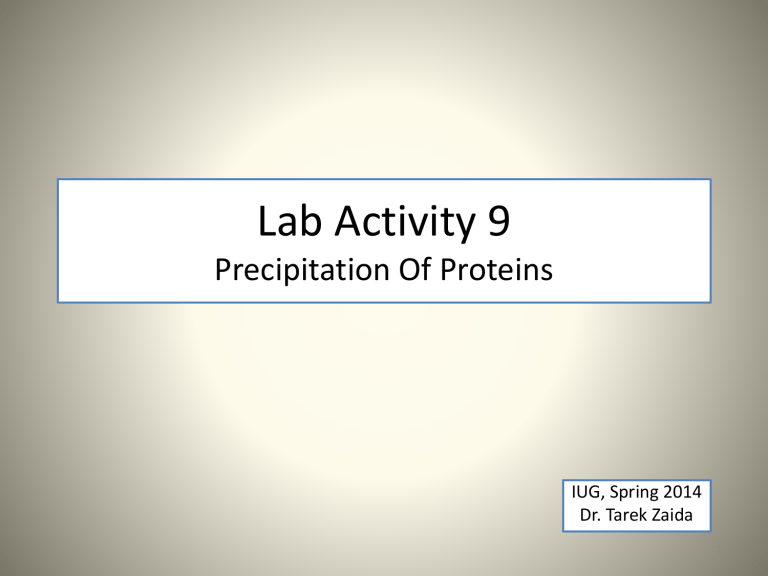Lab Activity 9 Precipitation Of Proteins

Lab Activity 9
Precipitation Of Proteins
IUG, Spring 2014
Dr. Tarek Zaida
1
Protein Precipitation
• Proteins are precipitated from solution by:
1. Certain acids some of which are alkaloidal reagents such as picric-, and tannic acid
2. Salts of heavy metals such as HgCl
2
,
CuSO
4
, Pb(C
2
H
3
O
2
) etc.).
AgNO
3. By conc. Solution of (NH
4
)
2
SO
4
, Na
2
SO
4
,
3
,
NaCl,
4. By dehydrating agents such as alcohol
(ethanol, methanol), acetone.
5. Isoelectric point.
2
1. Effect of strong Acids and Alkali
• Reagents:
• 1% solution of egg albumin,
• conc. HNO
3
, H
2
SO
4
, HCl, and acetic acids,
• conc. NaOH
3
Procedure
1. Place 2 ml of conc. HNO
3 in a test tube, inlcine the tube and add the dilute albumin slowly from a pipette, allowing the solution to run down the side of the tube and form a layer over the nitric acid.
Note the appearance of a protein precipitate at the zone of contact between the two fluids.
2. Now mix the contents of the tube thoroughly by careful shaking.
Is protein precipitated by conc. HNO
3
?
4
3. Repeat the above steps using conc. H
2
SO
4
, conc. HCl, acetic acid, and NaOH.
- Observe what happens in each case, then compare it with the first experiment with
HNO
3
.
5
2. Precipitation by Metallic Salts
• Reagents
• 1% Solution of egg albumin,
5% solution HgCl
2
, CH
3
COOPb,CuSO
4
,
• 1% solution of AgNO
3
6
Procedure
1. Prepare 4 test tubes, each containing 2 to 3 ml of dilute albumin sol., to the first test tube add HgCl
2 sol., drop wise slowly until an excess of the reagent has been added.
2. Record your observations.
Unless the reagent is added very slowly, the formation of the precipitate may not be noted, due to it’s solubility in excess of the reagent.
7
• 3. Repeat the above exp. With CH
3
COOPb,
CuSO
4
, and AgNO
3
8
3. Precipitation by Alkaloidal Reagents
• Reagents
• 1% albumin solution, sat. sol. Of picric acid,
10% trichloroacetic acid solution (TCA), tannic acid sol., Phosphotungstic acid sol.
9
Procedure
1. Prepare 4 test tubes each containing 2 to 3 ml of albumin sol.
2. To the first test tube add picric acid drop wise, until an excess of the reagent has been added.
3. Note any change that may occur.
4. Repeat the exp. With Trichloroacetic acid sol.,
Tannic acid sol., phosphotungstic acid sol.
5. Are these precipitates soluble in excess of the reagent? (acidify with hydrochloric acid before testing with the last 2 reagents).
10
4. Precipitation by K
4
[Fe(CN)
6
] · 3H
2
O
• Reagents
• 1% Albumin sol., 1% potassium ferrocyanide sol.
11
Procedure
1. To 5 ml of albumin sol., in a test tube add 5 to 10 drops of acetic acid, mix well and add potassium ferrocyanide drop by drop, until a precipitate forms.
2. Write down your observation
12
5. Fractional Precipitation of Proteins by Conc. Salt solutions
• Reagents
• Dilute egg white solution (mix 1 volume of raw egg with 4 volumes of 1 % NaCl and filter).
• Sat. sol. of (NH
4
)
2
SO
4
, 1% acetic acid solution.
13
Procedure
1. To a portion of the dilute egg-white sol. add an equal volume of a saturated sol. of (NH
4
)
2
SO
4 and mix. Does the egg white contain a portion which precipitates by half-saturated (NH
4
)
2
SO
4
?
2. If a precipitate is formed, then filter the content, and to the filtrate add an excess of solid (NH until the solution is saturated with salt.
4
)
2
SO
4 and stir
3. Record what happens? If a precipitate formed, filter and to the filtrate add 2 to 3 drops of 1% acetic acid sol. And heat to boiling.
4. If there is no precipitate formed, it indicates the absence of protein in the last filtrate.
14
6. Precipitation of Proteins at the
Isoelectric Point
Reagents
• Casein powder,
• Solutions of: 1 N NaOH, 1 N CH
3
COOH, H
2
O d
,
• Volumetric flask
15
Procedure
1. Into a 50 ml volumetric flask add 20 ml of water.
2. Add 0.25 g of pure casein, followed by the addition of 5 ml of 1 N NaOH solution.
3. Once casein is dissolved, add 5 ml of 1 N acetic acid solution, then dilute with H
2
O to 50 ml and mix well. The resulted solution is a 0.1
N casein acetate sodium.
16
4. Setup a series of 9 test tubes as shown in the table below.
5. In the first test tube put 3.2 ml 1 N CH
3
COOH, and 6.8 ml H
2
O and mix thoroughly.
6. In each of the other test tubes (2-9) put 5 ml
H
2
O d
.
7. From the test tube 1 transfer 5 ml to the test tube 2, and mix thoroughly.
17
8. Repeat step 7 for the rest of test tubes (3 - 9).
9. Now to each test tube (1 -9) add 1 ml of the casein acetate sodium solution, and shake the test tubes immediately.
10. Let the samples stand for 30 min, and note the turbidity in the 9 test tubes.
11. Use + / – signs to describe the turbidity in the different test tubes.
12. You should observe the most precipitation in the test tube which has the pH around 4.7
(close to the isoelectric point of casein).
18
T UBE
1 N
CH
3
COOH
1 2 3 4 5 6 7 8 9
1.6
0.8
0.4
0.2
0.1
0.05
0.025
0.012
0.006
P H
3.5
3.8
4.1
4.4
4.7
5.0
5.3
5.6
5.9
T URBIDITY
19









